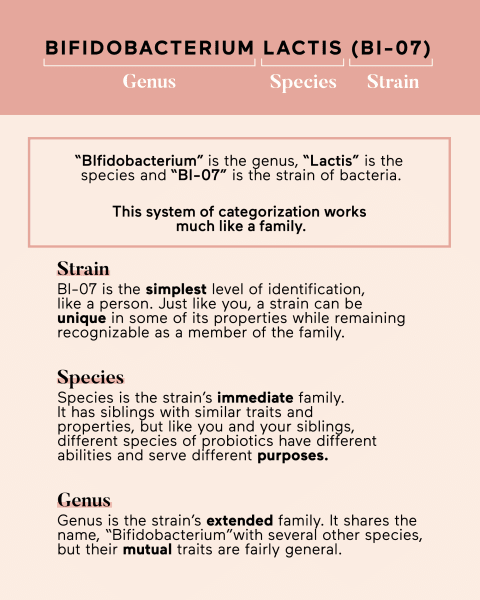In addition to filling our fridges with probiotic foods like yogurt and kombucha, probiotics have quickly become one of the most popular supplements in the United States. Despite their popularity, it’s important to note that there’s no one-size-fits-all approach to probiotics. There are many different types of probiotics—called strains—and each one has its own special function. Every person also has a unique gut microbiome—or balance of beneficial bacteria in the gut—so the best probiotic for you may be different from the ideal choice for someone else. To get the most benefits of probiotics, you need to find the strain(s) targeted to your specific symptoms. Aside from supporting your gut health and alleviating uncomfortable digestive symptoms, like bloating and constipation, probiotics have also been linked to a healthier immune system, reduced cholesterol, improvements in allergy symptoms, and a lower rate of infections.* Because probiotics are so popular, manufacturers have made the supplements readily available in all forms. You can find them as pills, capsules, and powders. Probiotics are even frequently added to other supplements, like greens powders, to boost their nutritional value.* For example, when looking at Bifidobacterium lactis BI-07, Bifidobacterium is the genus, lactis is the species, and BI-07 is the strain. But what does that all mean? Below, we’ve broken it down. Lactobacillus ferment refined sugars and create lactic acid, while bifidobacteria mainly produce short-chain fatty acids, or SCFAs, although they create lactic acid too. Another difference is where they live and colonize (or grow). Lactobacillus naturally lives in the small intestine, while Bifidobacterium takes up residence in the large intestine (or colon). That also means that when you take a probiotic supplement, the Lactobacillus strains travel to—and grow in—your small intestine, while the Bifidobacterium strains have a longer journey to get to your large intestine. These different locations in your gut translate to different health benefits. In most adults, Bifidobacteria makes up 3 to 6%4 of the total gut microbiome, making it one of the most abundant genera5. There are about 48 different 6Bifidobacterium 6species6, and each affects your health in different ways. In general, some of the health benefits associated with Bifidobacteria include: Research shows that Lactobacillus can support gut barrier function11 by killing off potentially harmful bacteria.* There are about 170 different species of Lactobacillus, and the general health benefits include: Researchers have yet to identify every single probiotic strain out there (and it’s likely they never will), but that number currently is almost at 8,00014. Even though some bacterial strains may always remain a mystery, there are some have a long history of good research and clinical use. These include: Bifidobacterium lactis HN019: shown to promote regularity and provide relief from constipation15.* Bifidobacterium animalis DN-173 010 (nicknamed Bifidus regularis): may shorten colon transit time16, which can promote regularity and alleviate constipation.* Bifidobacterium longum BB536: promotes bacterial balance17 and homeostasis in the gut, which supports the immune system and alleviates digestive issues.* Bifidobacterium lactis UABla-12 and Lactobacillus acidophilus DDS-1: can improve abdominal pain18 and reduce the severity of other symptoms, like bloating, in adults with irritable bowel syndrome.* Lactobacillus casei Shirota and Bifidobacterium lactis DN-173 010: might increase stool frequency19 and improve stool consistency, which can help improve constipation and promote bowel regularity.* Lactobacillus rhamnosus GR-1 and Lactobacillus fermentum RC-14: can help restore normal vaginal flora20 and reduce the risk of bacterial and yeast vaginal infections.* Lactobacillus rhamnosus JB-1: positively affects GABA21, a neurotransmitter in the brain, and may reduce stress-related symptoms.* Lactobacillus casei BF1, BF2, and BF3: can inhibit the growth of Helicobacter pylori and Staphylococcus aureus22, two pathogenic bacteria well known for causing human infection and resulting health problems.* Lactobacillus reuteri NCIMB 11951, Lactobacillus reuteri NCIMB 701089, and Lactobacillus acidophilus ATCC 314: can promote healthy cholesterol levels23 and support heart health.* Lactobacillus plantarum DSM 9843: can improve gas and flatulence in people with irritable bowel syndrome.* That’s why it’s important to get your supplements from a reputable, high-quality manufacturer. He recommends choosing a probiotic that’s targeted to what you’re trying to treat, contains multiple strains, and 5 to 100 billion colony-forming units (CFUs). It’s also a good idea to make sure your probiotic is tested by a third-party lab to ensure that it contains what it says and that the bacterial strains are alive and doing their jobs. Note that while many probiotic supplements are refrigerated to help with this, high-quality supplements can also be made shelf-stable and don’t require refrigeration. For more specific recommendations, check out one of our probiotics roundups. Understanding the different strains is key to finding a targeted supplement and reaping those benefits.* She has written twelve books and has had more than 2,000 articles published across various websites. Lindsay currently works full time as a freelance health writer. She truly believes that you can transform your life through food, proper mindset and shared experiences. That’s why it’s her goal to educate others, while also being open and vulnerable to create real connections with her clients and readers.




